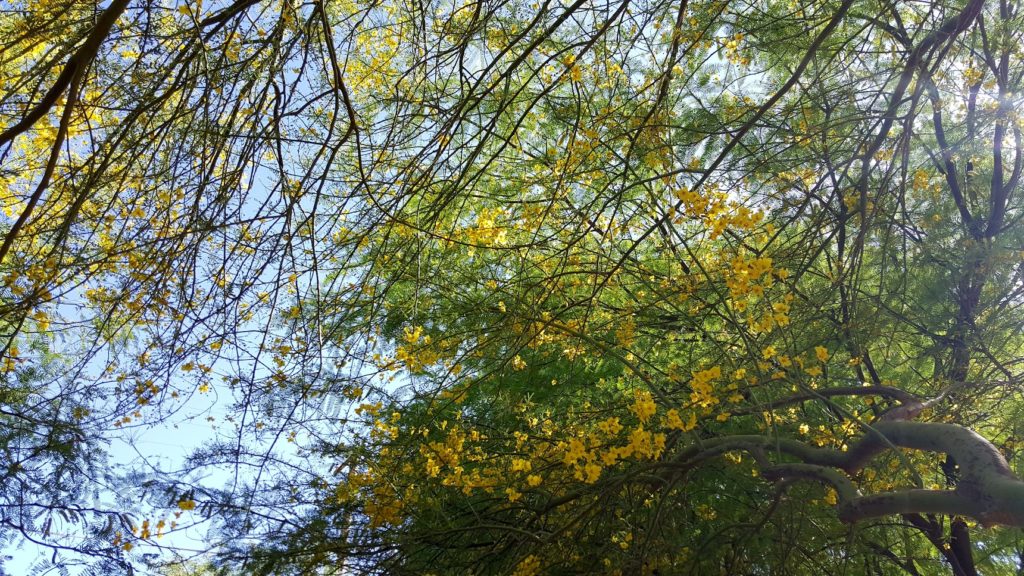It’s May in Tucson and the thermometer is regularly creeping into triple digits by early afternoon. Knowing that the heat would be uncomfortable later today, I spent my morning in our backyard; I completed some maintenance, exercised, and ate breakfast al fresco. Then I positioned a chaise lounge under the shade of a tree, placed a small table next to it for my ice water, and dug into a book. The world disappeared for a few hours until something wet landed on my shirtless belly. Bird poop.
I cleaned the poop off and moved my lounge into a corner of the yard less likely to be in the line of fire. I set my book down and looked into the canopy to observe what was going on up there. Tiny House Finches flitted about in the branches of a mesquite tree, showing off their bright red breasts and singing their bubbly songs. Lizards darted up and down limbs, turning to stone from time to time as they hunted insects. A barred black and white Gila Woodpecker sporting a red crown (male) stopped by, probably checking out nesting territory, and a grey Curve-billed Thrasher curiously pecked on palm fronds. The palo verde trees dominated the scene with myriad yellow blossoms. Occasionally, flowers detached and gently drifted to the ground like snowflakes.
When we bought this house, the property had four trees: a palm and a mesquite–both recently planted–a lemon tree, and a grapefruit tree. The grapefruit tree sprouted near the east lot line after my prior neighbor’s son planted the seed over half a century ago from a grapefruit his mom had eaten. Today, the tree towers forty feet over the properties and provides wonderful shade and a green buffer between the houses. The lemon tree succumbed to an unusually harsh winter freeze a few years ago, and the mesquite toppled in a Monsoon storm.
We have planted more trees over the years and mother nature planted two trees–a palm and a mesquite–all on her own. We now have twenty-three trees on less than a fifth of an acre! In addition to our citrus tree, the palms, and our bosque of mesquites and palo verdes, we have several Australian bottle trees, most of which grow along our western boundary to provide privacy and a shield against the blazing sun as it sinks in the afternoon and aims its light like a laser toward our yard. Adaptive to the desert environment, none but the youngest of our trees is on irrigation. Thus, our twenty-three trees help clean the air, absorb heat, and they do not pressure water resources. The trees look pretty, too, and provide shade for us and habitats for God’s creatures.
Fittingly, the book I was reading this morning in the backyard is about Stoicism. I enjoy Stoic philosophy; it complements notions that I respect from both Buddhism and Christianity. Among other concerns, Stoics sought to answer the question of how to remind ourselves to appreciate life as it is and the things that we already have. Accordingly, Stoics developed a technique called negative visualization.
Negative visualization involves imagining that we have lost what we already have. The idea is that by imagining the loss and recognizing impermanence, we are reminded to be grateful for what we have at this moment (and we are prepared for when we might no longer have it). Through negative realization, I could imagine my backyard without the trees: no birds, no lizards, no shade. With no shade, I wouldn’t be out there because the yard would be too hot, and I’d get fried by the sun. That negative realization of a barren backyard helps me to appreciate that I do, in fact, have a backyard filled with beautiful, giving trees. I am reminded to be thankful for what I have, presently.
Negative visualization is useful medicine in small doses. I find the technique a bit dark, though, for persistent use. For example, I wouldn’t want to think too often about not having my son or my wife or my house or my job and so forth. Nevertheless, I cherish the concept of being conscious of the countless blessings in our lives, and if it takes a little bird poop once in a while to awaken gratefulness, whether it comes in the form of negative realization or from an actual bird, so be it.
With Love,
P. Gustav Mueller, author of The Present.
